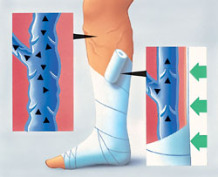VenUS IV - An RCT to compare compression hosiery with 4-layer compression bandaging for ulcer healing and quality of life
VenUS IV investigated whether two-layer hosiery improves ulcer healing rates and is cost effective compared to four-layer bandages. There was no difference in healing rates and two-layer hosiery may reduce ulcer recurrence rates and be more cost-effective.
Why did we do this research?
Venous leg ulcers are common, chronic wounds that are painful and reduce quality of life. The application of compression is known to assist in the healing of venous leg ulceration. The four-layer bandage was the current gold standard treatment for healing venous leg ulcers. Two-layer hosiery had been designed to deliver the same amount of compression as the four-layer bandages with the potential advantages of being easier for patients to wear and apply.
What did we do?
We undertook a randomised controlled trial to compare the clinical and cost effectiveness of the two different treatments for leg ulcers. GP practices and specialist ulcer, wound, and vascular teams in acute and community settings across the NHS in England and Northern Ireland were involved in recruiting and following-up patients for this trial. We randomised 457 people with venous leg ulcers to receive either two-layer hosiery or a four-layer bandage. The primary outcome was time to healing of the reference ulcer (blinded assessment).
Who was involved?
Participants were eligible if they had a venous leg ulcer, were at least 18 years of age, had an ankle-brachial pressure index of at least 0.8 and were willing and able to tolerate high compression.
What did we find?
There was no difference in time to healing between the two groups. However, we did find that two-layer hosiery may reduce ulcer recurrence rates compared with the four-layer bandage. Two-layer hosiery also appeared to be the most cost-effective treatment.
What happens next?
Newer treatments such as two-layer bandage and compression wraps are being assessed in a subsequent trial called VenUS 6.
Publications
- Ashby R, Gabe R, Ali S, Saramago P, Chuang L, Adderley U, et al. VenUS IV (Venous leg Ulcer Study IV): Compression hosiery versus compression bandaging in the treatment of venous leg ulcers: a randomised controlled trial, mixed treatment comparison and decision analytic model. Health Technol Assess 2014;18(57) https://www.journalslibrary.nihr.ac.uk/hta/hta18570/#/abstract
- Ashby, Rebecca L et al. Clinical and cost-effectiveness of compression hosiery versus compression bandages in treatment of venous leg ulcers (Venous leg Ulcer Study IV, VenUS IV): a randomised controlled trial. The Lancet, Volume 383, Issue 9920, 871 - 879 https://www.thelancet.com/journals/lancet/article/PIIS0140-6736(13)62368-5/fulltext
Privacy Notice: How we use your research data
Study Registration
The trial was registered with the ISRCTN: https://www.isrctn.com/ISRCTN49373072


